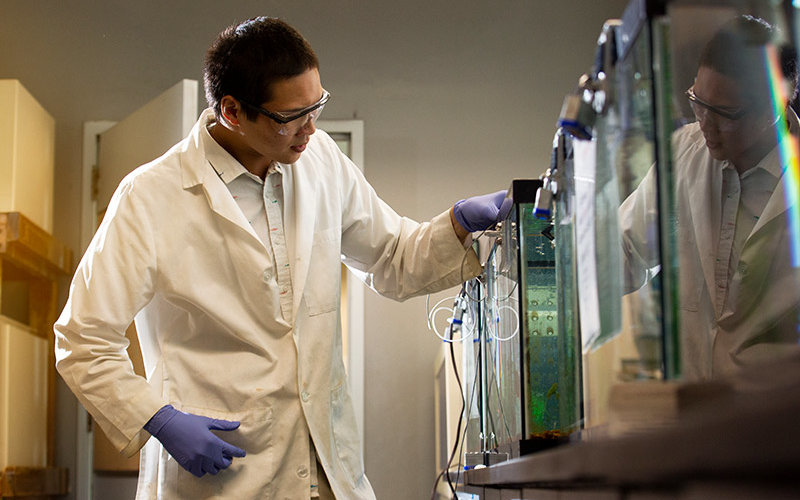
As a boy, Andrew Lowe had goldfish for pets. Nowadays, the biology graduate student gets to work with piranhas.
Inside a lab in Dan Black Hall, he tends to tanks of red-bellied piranhas with razor-sharp teeth and tiny armored corydoras catfish, natives of the Amazon, for his research project.
The piranhas watch Lowe as he paces in front of the tanks. Surprisingly, he noted, piranhas are omnivores. He feeds them peas three times a week, as well as shrimp and bloodworms.
Lowe is spearheading a study with faculty mentor Misty Paig-Tran, assistant professor of biological science, about how catfish scales act like armor and may protect the fish from attacks. His research could potentially lead to creating flexible armor for humans such as gardening gloves resilient to puncture from thorns, flexible body armor for soldiers and shark-bite resistant wetsuits.
“My research focuses on the toughness, strength and flexibility of corydoras catfish scales, and the bite forces of the red-bellied piranhas,” said Lowe, who studies a field called biomimetics, which is the imitation of nature to solve human problems.
Lowe also is interested in the field biomechanics, or how biological things move and work, which is an area of research Paig-Tran focuses on as well.
“My research combines the two emerging fields in biology and allows me to sprinkle in some animal behavior, too,” he said. “During my two years in Dr. Paig-Tran’s lab, I have learned a lot about material and mechanical properties, ichthyology — the scientific study of fishes — animal husbandry, public speaking, and teaching and mentoring others.”
Lowe, who earned his bachelor’s degree from UC Berkeley, where he studied molecular and environmental biology, is on track to graduate in May and earn his master’s degree. He has presented his research at local and state conferences and currently is working on finalizing data collection for his thesis project. He is a member of CSUF’s Biology Graduate Student Club and Society of Integrative and Comparative Biology.
“So far, I have found that the catfish’s bony scales, called scutes, are about as tough as bronze,” Lowe said. “Catfish are able to slide their scutes into place so that they overlap and reinforce each other — making for an even tougher armor.
“However, the catfish’s external body doesn’t have scutes all over to provide protection, so there are weak points in the fish’s armor.”
Lowe is working toward submitting his project for publication in a scientific journal, as well as strengthening and honing his lab and research competences, and improving problem-solving and critical-thinking skills. His goal is to land a position in research and development in the field of biomimetics.
“Dr. Paig-Tran has been instrumental in my progress so far and has been a great fit for me as a research adviser. She has given me license to think freely about my own research project — and let me swim,” Lowe said.